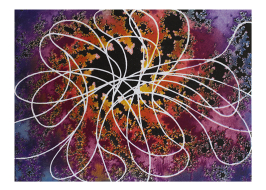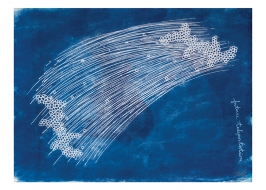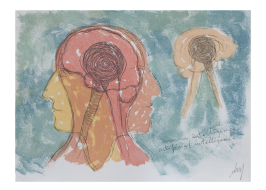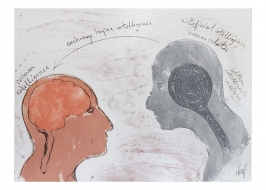Micha Laury"Road Map"Stone Administration Building, first floor1
Present Time and Millions of Years (+10100) – fifteen etchings
There are few things that arouse our curiosity more than the urge to know what lies ahead. What extremes will life attain as it evolves into the distant future? Is there a finite limit to the Universe? Micha Laury, in a new series of etchings, tests out some possible answers, or else presents us with some theoretical milestones in future evolution – both of the Universe and humanity. The physicist Freeman Dyson, in his essay collection Infinite in all Directions, denies that consciousness is separate from matter. That is, the difference between mere matter and a mind capable of composing a string concerto is one of degree and not of substance.
He expounds that the evolution of living systems is not just a function of biological adaptation, but ultimately depends on the continuing evolution of the Universe. If one posits a closed universe – one that ends in a “big crash” – then life will end with it. But an open universe, which will expand indefinitely into the future, will grant life the opportunity to increase and survive (at least until the very particles making up the universe might finally be extinguished, marking the ultimate end).
The etchings in Laury’s exhibit are like a series of snapshots, each portraying a “situation” (or “dilemma”) that, taken together, create a sort of road map with signposts to the future. At first, the series is clearly rooted in the realm of the human: a laboratory, which symbolizes human curiosity and hope for the future. The final leg of the series is rooted in theory: Dead Universe Expands Forever offers a vision that lies beyond the Universe as we know it – the eternal expansion of nothingness.
Between the two – the present and the end of the Universe – Laury presents hypothetical questions: What is wisdom? Does the Universe function as a giant brain? Will humans one day be able to meld their brains to attain synergistic enlightenment? Or might it be preferable and easier to imagine combining innate intelligence with artificial intelligence? Will evolution eventually divide humanity into sub-species by profession or caste? How will the relationship of humans to their environment unfold? Can we (or when will we) succeed in colonizing other planets? Will it be possible to teleport people and things directly to other worlds?
What has happened/is happening/will happen in the intervals between these snapshots? Can we even define the connection between universal and human evolution (over and above the practical issue Dyson hinted at)? Laury leaves these questions to the viewer – and to future generations – to answer.
Micha Laury was born on Kibbutz Negba in 1946. Since 1975, he has been living and working in Paris. His works have been exhibited in museums and galleries around the world. In 2013-2014, major exhibits of Laury’s work will be mounted in the Kunstmuseum Bochum and Museum Goch in Germany; the Museum of Modern Art, Saint-Étienne, in France; and the Museum of Art, Ein Harod, and the Weizmann Institute of Science in Israel.
Laury works in a wide range of media; his creations are an expression of the uncompromising struggle of the individual in a closed social system toward personal space. In one famous installation, Don’t be a Chocolate Soldier, he placed edible candy soldiers in the museum. This work and others reference Francisco Goya’s Disasters of War (depicting Napoleon’s invasion of Spain in 1813-1814).
Curator: Yivsam Azgad





